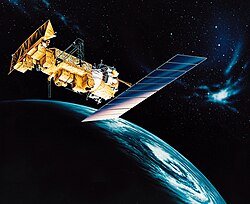 TIROS-9 satellite | |
| Mission type | Weather satellite |
|---|---|
| Operator | NASA |
| COSPAR ID | 1965-004A |
| SATCAT no. | 978 |
| Spacecraft properties | |
| Spacecraft type | TIROS |
| Manufacturer | RCA / GSFC |
| Launch mass | 138.30 kilograms (304.9 lb) [1] |
| Dimensions | 1.07 m × 0.56 m (3.5 ft × 1.8 ft) |
| Start of mission | |
| Launch date | January 22, 1965, 07:52 UTC [2] |
| Rocket | Thor-Delta C 374/D-28 |
| Launch site | Cape Canaveral LC-17A |
| End of mission | |
| Last contact | February 15, 1967 |
| Orbital parameters | |
| Reference system | Geocentric |
| Regime | Low Earth |
| Eccentricity | 0.11693 [1] |
| Perigee altitude | 705 kilometers (438 mi) [1] |
| Apogee altitude | 2,582 kilometers (1,604 mi) [1] |
| Inclination | 96.43° [1] |
| Period | 119.23 minutes [1] |
| Epoch | January 22, 1965 [1] |
| Instruments | |
| Television Camera System | |
TIROS-9 (also called TIROS-I or A-54) was a spin-stabilized meteorological satellite. It was the ninth in a series of Television Infrared Observation Satellites.
